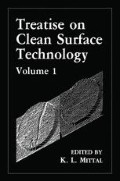Abstract
When two materials are touched together and then separated, we find, in general, that charge has transferred between them. This phenomenon is known as contact electrification or contact charging. It is most apparent when one or both of the contacting materials is an insulator, because of the ability of an insulator to retain charge. Contact charging is one of the oldest studied phenomena in physics but is still incompletely understood. Despite this, considerable use is made of these effects in industrial processes. It is the basis of xerography, electrostatic precipitators, electrostatic paint and crop spraying, and ink jet printing and is made use of in a wide variety of other applications. Contact charging can also be a considerable nuisance, causing irritating electric shocks in the home and office environment. Many semiconductor devices are highly susceptible to damage from acquired static charges. The buildup of static charges and their subsequent discharge can be extremely hazardous in flammable and explosive environments.
Access this chapter
Tax calculation will be finalised at checkout
Purchases are for personal use only
Preview
Unable to display preview. Download preview PDF.
References
J. Lowell and A. C. Rose-Innes, Contact electrification, Adv. Phys.29(6), 947–1023 (1980).
Proceedings of Conferences on Static Electrification, Institute of Physics Conference Series, No. 11 (1971), No. 27 (1975), No. 48 (1979), No. 66 (1983).
Proceedings of the 4th International Conference on Electrostatics, The Hague (1981), J. Electrostat.10(1981).
Proceedings of the 5th International Conference on Electrostatics, Uppsala (1985), J. Electrostat. 16 (1985).
K. P. Homewood, An experimental investigation of the depth of penetration of charge into insulators contacted by a metal, J. Phys. D 17, 1255–1263 (1984).
W. R. Harper, Contact and Frictional Electrification, Oxford University Press, Oxford (1967).
H. Bauser, W. Klopffer, and H. Rabenhorst, On the charging mechanism of insulating solids, Adv. Static Elec. 1, 2–9 (1970).
G. A. Cottrell, C. Reed, and A. C. Rose-Innes, Contact electrification of ideal insulators: Experiments on solid rare gases, in: Static Electrification, Institute of Physics Conference Series, No. 48, 249–256 (1976).
J. Lowell, Surface states and contact electrification of polymers, J. Phys. D. 10, 65–71 (1977).
K. P. Homewood, Do ‘Dirty’ surfaces matter in contact electrification experiments? J. Electrostat. 10, 299–304 (1981).
K. P. Homewood, An experimental investigation of the contact electrification of insulators by metals, Ph.D. Thesis, University of Manchester, England (1981).
P. S. H. Henry, Generation of static on solid insulators, J. Text. Inst. 48, 5–25 (1957).
E. S. Robins, A. C. Rose-Innes, and J. Lowell, Are adsorbed ions involved in the contact charging between metals and insulators?, in: Static Electrification, Institute of Physics Conference Series, No. 27, 115–121 (1975).
E. S. Robins, J. Lowell, and A. C. Rose-Innes, The role of surface ions in the contact electrification of insulators, J. Electrostat. 8, 153–160(1980).
M. I. Kornfeld, Nature of frictional electrification, Soviet Phys. Solid State 11, 1306–1310 (1969).
M. I. Kornfeld, Frictional electrification, J. Phys. D 9, 1183–1192 (1976).
T. Horvath and I. Berta, The effective location of eliminators in the electric field of moving sheet materials at conducting rollers, in: Proceedings of the International Conference on Static Electricity, Grenoble (1977), p. 32(a).
T. Horvath and I. Berta, Mathematical simulation of electrostatic hazards, in: Static Electrification, Institute of Physics Conference Series, No. 27, 256–263 (1975).
J. F. Hughes, A. M. K. Au, and A. R. Blythe, Electrical charging and discharging between films and metal rollers, in: Static Electrification, Institute of Physics Conference Series, No. 48, 37–44 (1979).
J. S. Forrest, Methods of increasing the electrical conductivity of surfaces, Br. J. Appl. Phys. 4, Suppl. 2, S37–39 (1957).
Y. Awakuni and J. H. Calderwood, Water vapour adsorption and surface conductivity in solids, J. Phys. D 5, 1038–1045 (1972).
G. W. Brundrett, A review of the factors influencing electrostatic shocks in offices, J. Electrostat. 2, 295–315 (1976/1977).
S. P. Hersh, Review of electrostatic phenomena on textile materials, Dechema Monographs 72, 199–216 (1974).
J. E. McIntyre, Antistatic fibers, Rep. Prog. Appl. Chem. 59, 99–108 (1974).
E. L. Zichy, Antistatics for plastics, Dechema Monographs 72, 147–161 (1974).
A. R. Blythe, Device for controlling static charge levels on film, in: Static Electrification, Institute of Physics Conference Series, No. 27, 238–245 (1975).
J. Boyd and D. Bulgin, The reduction of static electrification by incorporating viscose rayon containing carbon, J. Text. Inst. 48, 66–99 (1957).
D. A. Hays, The effect of oxidation and an electric field on the contact electrification of polyethylene by mercury, Dechema Monographs 72, 95–103 (1974).
D. A. Hays, Contact electrification between mercury and polyethylene: Effect of surface oxidation, J. Chem. Phys. 61, 1455–1462 (1974).
M. Selders, F. K. Dolezalek, O. Frenzl, and H. Rabenhorst, Contact electrification of corona treated polyethylenes, J. Electrostat. 10, 315–320 (1981).
H. Bauser, Static electrification of organic solids, Dechema Monographs 72, 11–28 (1974).
D. K. Davies, The generation and dissipation of static charge on dielectrics in a vacuum, in: Static Electrification, Institute of Physics Conference Series, No. 4, 29–36 (1967).
W. R. Salanek, A. Paton, and D. T. Clark, Double mass transfer during polymer-polymer contacts, J. Appl. Phys. 47, 144–147 (1976).
J. Lowell, The role of material transfer in contact electrification, J. Phys. D 10, L233–235, (1977).
D. Briggs, The role of modern surface analysis techniques in understanding electrification phenomena, in: Static Electrification, Institute of Physics Conference Series, No. 48, 201–213 (1979).
J. M. Chen, Mechanism of work function reduction by oxygen adsorption, J. Appl. Phys. 41, 5008–5011 (1971).
Author information
Authors and Affiliations
Editor information
Editors and Affiliations
Rights and permissions
Copyright information
© 1987 Plenum Press, New York
About this chapter
Cite this chapter
Homewood, K.P. (1987). Surface Contamination and Contact Electrification. In: Mittal, K.L. (eds) Treatise on Clean Surface Technology. Springer, Boston, MA. https://doi.org/10.1007/978-1-4684-9126-5_10
Download citation
DOI: https://doi.org/10.1007/978-1-4684-9126-5_10
Publisher Name: Springer, Boston, MA
Print ISBN: 978-1-4684-9128-9
Online ISBN: 978-1-4684-9126-5
eBook Packages: Springer Book Archive

